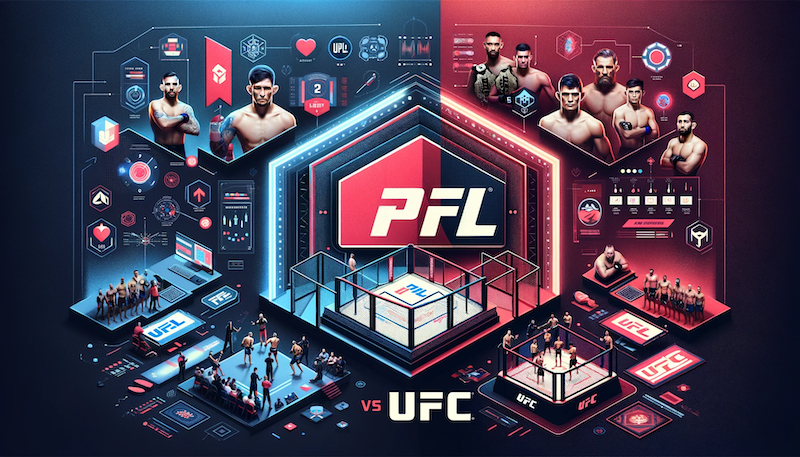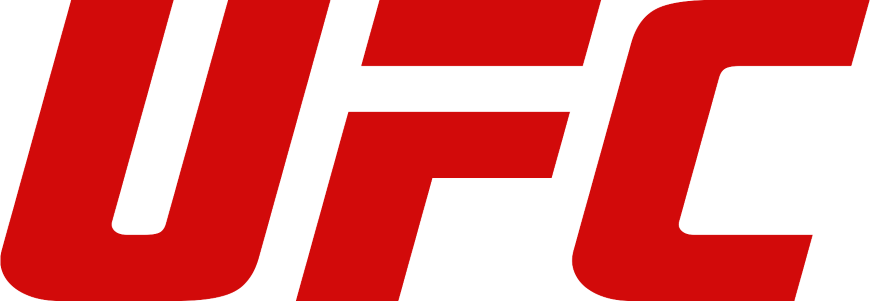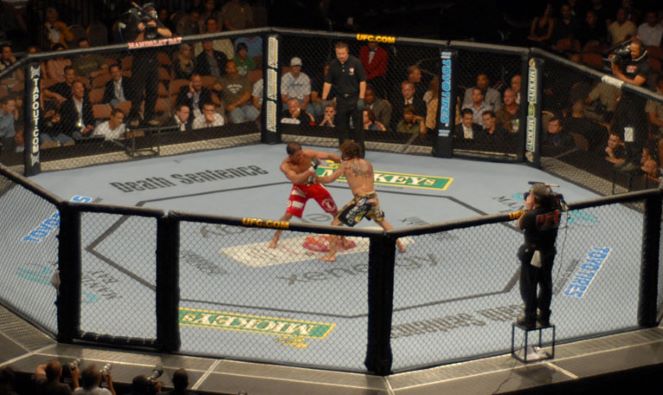
Are you wondering what differences are between the PFL and the UFC?
In this article, we examine 12 key differences between the two MMA promotions.
Contents
PFL vs UFC (12 Differences Examined)
In short, the biggest difference between the PFL and the UFC is how the PFL is structured in a seasonal league format, while the UFC is without a structure and operates year-round via traditional matchmaking.
Other differences include: the PFL doesn’t allow elbows, the cages differ, the UFC has a much larger presence, a much larger roster, and is an overall much larger promotion – at least 24 times larger in terms of valuation.
Here’s a list of the 12 main differences between the PFL and the UFC with a short description for each:
1. Format
- PFL: Operates in a seasonal league format with playoffs and championships.
- UFC: Follows a year-round event-based schedule with conventional matchmaking.
2. Weight Classes
- PFL: Features 6 weight classes (5 men’s and 1 women’s).
- UFC: Offers 11 weight classes (8 men’s and 3 women’s).
3. Weight Miss Penalties
- PFL: Implements a 1-point deduction and 20% purse penalty for missing weight.
- UFC: Enforces 20-30% purse deductions, ineligibility for bonuses, and other sanctions in collaboration with athletic commissions.
4. Fighter Pay
- PFL: $1 million prize for season champions and a range of fighter pay for each fight.
- UFC: Offers varied pay based on fighter status, including PPV points for top fighters, $50,000 performance bonuses, discretionary bonuses, and more.
5. Sponsorships
- PFL: Allows fighters to display 2 personal sponsors on their fight gear.
- UFC: Requires fighters to wear Venum gear and doesn’t allow individual sponsorships to be worn.
6. Cage
- PFL: Utilizes a 10-sided cage with a diameter of 28 feet and SmartCage technology.
- UFC: Uses its trademarked 8-sided Octagon, available in standard (30-foot diameter) and smaller sizes (25-foot diameter).
7. Illegal Techniques
- PFL: Bans elbow strikes to minimize cuts and fight stoppages.
- UFC: Allows elbow strikes, except for the 12:6 downward elbow.
8. Match Duration
- PFL: Regular season and playoff fights are 3 rounds; only championship fights are 5 rounds.
- UFC: Non-title fights are 3 rounds; title fights and main events are 5 rounds.
9. Global Presence
- PFL: Primarily focused on the U.S. market, with recent expansion into Europe.
- UFC: Has a strong international presence, hosting events worldwide: in North and South America, Europe, Asia, and Australia.
10. Roster and Talent Pool
- PFL: Mix of up-and-coming fighters and veterans, with a developing roster, often between 68 to 76 fighters.
- UFC: Boasts a large, diverse roster of over 600 where the best and most globally recognized MMA fighters compete.
11. Size in Numbers
- PFL: Valued at over $500 million, with a focus on growth and expansion.
- UFC: Valued at $12.1 billion, with substantial annual revenue, profit, and global market leadership.
12. Revenue Sharing: PFL’s Superfight Division
- PFL: Introducing a Superfight Division in 2024 with a 50/50 PPV revenue split.
- UFC: Offers a varied PPV points system, with top fighters earning lower percentages but higher earnings due to a high volume of PPV sales.
While this was a short description, here’s a closer look at the PFL vs UFC differences.
1. Format
PFL – Seasonal League

Unique League Structure: The PFL revolutionized MMA by introducing a league structure similar to major league sports like the NFL.
It’s the first MMA promotion to adopt a season, playoffs, and championship format, distinguishing it as MMA’s only true league.
Regular Season and Playoffs: The PFL’s regular season features between 68 and 76 fighters, divided across 5 weight classes for men and 1 for women. Fighters compete in 2 fights throughout the regular season.
Points Scoring System: Fighters earn 3 points for each win in the regular season.
Bonus Points for Finishes: The PFL incentivizes early finishes. Fighters receive bonus points for wins by knockout or submission, with the number of bonus points varying based on the round the fight ends:
- 3 bonus points for a first-round finish.
- 2 bonus points for a second-round finish.
- 1 bonus point for a third-round finish.
Advancement to Playoffs: Fighters accumulate points over the regular season. The top 4 fighters in each weight class, based on their total points, advance to the playoffs (semi-finals and finals).
UFC: Year-Round Matchmaking Format

Traditional Matchmaking: In contrast to PFL’s league format, UFC operates year-round, following a more traditional combat sports promotion model. This approach is heavily influenced by boxing.
The UFC relies on its matchmakers to arrange fights, with Dana White having the final say. Fights are scheduled throughout the year, and matchups are based on UFC fighter rankings, marketability, and strategic considerations.
Title Fights: The UFC doesn’t follow a seasonal structure for its title fights. Championship bouts are arranged based on the current rankings and market dynamics, often leading to high-profile and highly anticipated matchups.
2. Weight Classes
PFL Weight Classes
The PFL has 6 weight classes, 5 men’s and 1 women’s, and are as follows:
- Women’s lightweight division (155 lbs) – First and only in MMA
- Men’s featherweight (145 lbs)
- Men’s lightweight (155 lbs)
- Men’s welterweight (170 lbs)
- Men’s light heavyweight (205 lbs)
- Men’s heavyweight (265 lbs)
UFC Weight Classes
The UFC has 11 weight classes, 8 men’s and 3 women’s, and are as follows:
| Weight Division | Minimum and Maximum Weight Limit |
| Strawweight (women only) | 105 to 115 lbs (47.6 to 52.16 kg) |
| Flyweight (men and women) | 115 to 125 lbs (52.16 to 56.7 kg) |
| Bantamweight (men and women) | 125 to 135 lbs (56.7 to 61.2 kg) |
| Featherweight (men only) | 135 to 145 lbs (61.2 to 65.77 kg) |
| Lightweight (men only) | 145 to 155 lbs (65.77 to 70.3 kg) |
| Welterweight (men only) | 155 to 170 lbs (70.3 to 77.1 kg) |
| Middleweight (men only) | 170 to 185 lbs (77.1 to 83.91 kg) |
| Light Heavyweight (men only) | 185 to 205 lbs (83.91 to 93 kg) |
| Heavyweight (men only) | 205 to 265 lbs (93 to 120.2 kg) |
The UFC had 12 weight classes until September 2023, but they scrapped the women’s featherweight division as it struggled to find talented fighters for the division since its introduction in February 2017.
Note: The same minimum and maximum weight limits of each weight class division also applies to the PFL’s weight classes.
3. Weight Miss Penalties
PFL
Point Deduction: Fighters who miss weight are deducted 1 point from their season tally.
Purse Deduction: There’s a 20% purse deduction for missing weight, which is paid to the opponent (if they made weight).
2023 Rule Changes
PFL fighters who miss weight still incur a 1-point deduction but they’re now eligible to earn points from their bout. This adjustment offers a more lenient approach compared to previous seasons.
Previous Seasons
Prior to 2023, PFL fighters who missed weight were ineligible to earn any points from their bout, a rule that served as a stringent deterrent against weight misses.
UFC
Purse Deduction: Fighters missing weight face a deduction ranging from 20-30%, and sometimes up to 40%, of their total earnings.
Ineligibility for Bonuses: Fighters who miss weight cannot receive performance bonuses like Fight of the Night or Knockout of the Night. If they win a Fight of the Night bonus it’s awarded to their opponent.
Ranking Progression: A fighter who misses weight cannot progress in their division’s rankings, even if they win the bout.
Title Fight Implications: In title bouts, a challenger who misses weight cannot win the title, and a champion who misses weight is stripped of their title.
Divisional Movement or Release: Fighters who repeatedly miss weight may be forced to move up a weight class or risk being released from the UFC.
4. Fighter Pay
PFL Fighter Pay
Tournament Prize: The standout feature of PFL’s pay structure is the $1 million prize for each weight class champion at the end of the season.
Regular Season Pay: Fighters receive payment for each PFL fight during the regular season and playoffs. This can either be a flat fee or a show-and-win payment.
While there’s less information about PFL fighter pay as the promotion is only 5 years old, the pay tends to range from $10,000 to $100,000 for each fighter, with the bigger-name fighters earning much more.
As reported by MMA Fighting, some higher-earning examples include:
- Anthony Pettis: $750,000 (flat fee)
- Kayla Harrison: $500,000 (flat fee)
- Rory MacDonald: $250,000 (flat fee)
- Omari Akhmedov: $206,000 ($103,000 show + $103,000 win)
- Jeremy Stephens: $200,000 ($100,000 show + $100,000 win)
UFC Fighter Pay
Base Pay and Win Bonus: UFC fighters are paid per fight, with a base pay (show money) and a potential win bonus. The amount varies significantly based on the fighter’s contract and tier (low, medium, or high).
Those tiers are:
- Low-tier base payment for each fight: $10,000 to $30,000
- Medium-tier base payment for each fight: $30,000 to $200,000
- High-tier base payment for each fight: $200,000 to $3,000,000 (reserved for superstars, champions, and title challengers)
UFC fighters can also be paid a flat fee, rather than show and win, but this is usually reserved for the medium-higher-tier fighters earning at least $100,000.
Performance Bonuses: The UFC offers bonuses for exceptional performances, including Fight of the Night and Performance of the Night, each worth $50,000.
PPV Points: Top UFC fighters, especially champions and major draws, may receive a cut of the pay-per-view revenue, significantly boosting their earnings.
This is either part of their UFC contract or negotiated during the UFC bout agreement (signed before each fight).
Fight Week Incentive Pay: This is a payment from the UFC’s partnership with Venum, based on the number of fights a fighter has had in the UFC.
Here’s a breakdown of the payments fighters earn for each UFC fight:
- 1-3 fights = $4,000
- 4-5 fights = $4,500
- 6-10 fights = $6,000
- 11-15 fights = $11,000
- 16-20 fights = $16,000
- 21+ fights = $21,000
- Title challengers = $32,000
- Champions = $42,000
Discretionary Bonuses: The UFC also has discretionary bonuses, which are awarded at Dana White’s discretion. They’re usually for exciting performances or fighters who stepped in on short notice.
They’re mostly given to fighters who didn’t quite make the cut for Fight of the Night or Performance of the Night bonuses but did more than enough to win either on another night.
Miscellaneous Payments: There are also various smaller ways UFC fighters are paid, and these are:
- Fighters receive a 50/50 split from all UFC NFT sales involving them; which are random and undisclosed amounts.
- Fighters receive 10% per the merchandise rights agreement of their contract for all merchandise sales involving a particular fighter’s name.
- Fighters receive an undisclosed amount per the ancillary rights agreement of their contract, for the use of their name on other products. For example, fighters on the UFC game by EA receive a fee.
- Full accidental health insurance to cover training or fight-related injuries up to $50,000 per year
5. Sponsorships
PFL Sponsorships
Although this could be considered part of fighter pay, it’s an important difference between the PFL and the UFC and deserves its own section.
PFL fighters are allowed to have their own sponsors. They can display 2 sponsors on their fight gear during PFL events, and 2 sponsors on weigh-in and walk-in apparel, such as hats and hoodies.

This freedom allows fighters to secure additional undisclosed income through personal sponsorship deals.
UFC Sponsorships
As mentioned in the fighter pay section, UFC fighters can’t display sponsors on their fight or walk-in gear. They must wear Venum fight gear when competing and are paid accordingly.
From 1993 to 2015, UFC fighters were allowed individual sponsors. However, this came to an end when the UFC signed an exclusive apparel deal with Reebok.
6. Cage
PFL Cage
Shape and Size: PFL fighters compete in a 10-sided cage with a 28-foot diameter.

SmartCage Technology: In 2019, PFL introduced the SmartCage in partnership with SMT. This cage is equipped with biometric sensors to provide real-time data to viewers, including:
- Speed of strikes (kicks and punches)
- Heart rate tracking
- Energy exerted
UFC Octagon
Shape and Size: The UFC’s Octagon is an 8-sided steel cage and comes in 2 sizes:
- Standard Octagon: 30 feet in diameter with 746 square feet of fighting space, used for venues with larger space.
- Smaller Octagon: 25 feet in diameter with 518 square feet of fighting area, used for events at the UFC Apex center and venues with smaller space.

Height and Construction
- Height from Canvas to Top of Fence: Both the standard and smaller Octagons have a height of 5 feet 9 inches (1.8m) from the canvas to the top of the fence.
- Height from Ground to Canvas: The height from the ground to the canvas is 4 feet (1.2m), providing a raised platform for the fights.
- Entrance Gates: The entrance gates are 3 feet wide (0.9m) and 5 feet high (1.5m).
Material and Design
- Floor Composition: The Octagon floor is made of OSB boards covered with about 2 inches of closed-cell foam (EVA or polyethylene), topped with a heavy-duty canvas.
- Fence Material: The fence is made of metal chain-link, coated with black vinyl, with foam padding on top and between each of the eight sections.
- Safety Considerations: The design includes a small gap between the fence and the canvas, which, while generally safe, has occasionally posed a risk to fighters.
7. Illegal Techniques
Both the PFL and the UFC follow the Unified Rules of MMA but are free to ban certain techniques.
PFL Illegal Techniques
Elbow Strikes Ban: The PFL doesn’t allow elbow strikes in any form – whether standing, on the ground, or in the clinch.
Fighters who use elbows can be deducted 1 point and disqualified for repeat offenses.
Reason for the Ban: The primary reason for this ban is to minimize the risk of severe cuts and lacerations.
Elbows are known to cause deep cuts that can lead to doctor stoppages, impacting the outcome of fights and a fighter’s ability to compete in subsequent bouts.
Impact on Fighters: Given the PFL’s format of fighting every few months, deep cuts from elbows could hinder a fighter’s ability to train and compete in their next scheduled bout. The PFL wants to avoid this common disruption.
UFC
Elbow Strikes Allowed: In contrast, the UFC allows the use of elbow strikes, except for the 12:6 downward elbow. Jon jones infamously lost his only UFC fight to date due to using this illegal move against Matt Hamill in 2009.
Risk of Cuts: While elbow strikes in the UFC do lead to cuts and stoppages, the promotion’s event structure and lack of a regular season format like the PFL’s make this less of a logistical issue for fighters’ schedules.
Compulsory Suspensions: Under the Unfied Rules of MMA, fighters face a compulsory medical suspension of 60 days when suffering a facial laceration. However, they can fight sooner if cleared by a doctor.
Generally, this isn’t an issue as fighters often take at least 2 or 3 months off between fights to rest and recover.
8. Match duration
PFL
Length: Fights in the regular season and playoffs are 3 five minute rounds. Championship fights are 5 five minute rounds.
UFC
Length: Fights are 3 rounds of 5 minutes, while title fights and main event fights (last fight on the card) are 5 rounds of 5 minutes.
On rare occassions, the UFC turns a fight into a 5 round fight if they believe it worthy. This was the case for Leon Edwards vs Nate Diaz at UFC 263 (it was the third from last fight).
Overall, the difference is that the UFC has a lot more 5 round fights than the PFL does.
Title fights are taking place every month, and main card fights are happening every time there’s a UFC event, which is almost every week (40-42 events per year).
9. Global Presence
PFL
U.S. Focus: While the PFL launched PFL Europe in 2023, the PFL’s primary audience and operations remain predominantly in the United States.
The league’s format and presentation are tailored to resonate with American sports fans.
PFL Europe plans to hold events in cities like Newcastle (UK), Berlin (Germany), Paris (France), and Dublin (Ireland), indicating a strategic focus on the European MMA market.
UFC
Worldwide Events: The UFC has a well-established international presence, hosting events across the globe. This includes major markets in North America, South America, Europe, Asia, and Australia.
Diverse Fighter Roster: The UFC features fighters from many different countries, contributing to its global appeal and recognition. Notably, the UFC has many fighters from America, Brazil, Russia, and the UK.
International Broadcasts: UFC events are broadcast worldwide, making the promotion accessible to a global audience.
10. Roster and Talent Pool
PFL
Roster Composition: The PFL’s roster includes a mix of up-and-coming fighters and seasoned veterans who are mostly past their prime.
While it has a diverse array of talent, it has a much smaller pool of elite-level fighters compared to the UFC.
Notable Fighters: The PFL has made headlines with significant signings like Kayla Harrison, Claressa Shields, and Francis Ngannou.
However, despite having a few high-profile athletes, the PFL’s roster depth in terms of star power and elite fighters is small and still developing since its founding in 2018.
Roster Size: In recent seasons, the PFL has featured around 68-76 fighters across various weight classes. This number fluctuates slightly each season. The 2023 PFL roster has 74 fighters.
Focus on Talent Development: The PFL’s format and structure provide a platform for emerging talents to establish themselves and for veterans to rejuvenate their careers.
UFC
Deep Talent Pool: The UFC boasts a roster of around 600 fighters, making it the largest and most diverse talent pool in MMA. This number can fluctuate, as fighters are recruited and released often.
Global Recruitment: The UFC’s global presence allows it to recruit and feature fighters from all around the world, contributing to its rich and varied roster.
Star Power: The UFC is known for having numerous high-profile fighters and champions who are recognized globally. This includes a mix of established legends and rising stars.
Some of the biggest stars of the UFC include: Conor McGregor, Israel Adesanya, Jon Jones, Anderson Silva, Georges St-Pierre, and Khabib Nurmagomedov.
Competitive Landscape: The depth of talent in the UFC means that fighters face stiff competition at all levels, from newcomers to championship contenders.
UFC titles are frequently changing hands, except for the elite few who dominant their division such as Alexander Volkanovski (featherweight) and Islam Makhachev (lightweight)
11. Promotion Size
PFL
Valuation: Since August 2023, the PFL is estimated to be worth $500 million or more. It’s an estimated valuatin because the PFL is a private company.
This valuation is based upon a $30m Series E funding round in May 2022, which, as CNBC reported, valued the PFL at $500 million.
In August 2023, SRJ Sports Investments injected $100 million into the PFL. This hefty investment suggests the PFL’s worth has climbed well over the $500 million mark in 2023.
However, the valuation at which SRJ invested is unknown, as is how much of the PFL they secured with their $100 million.
Revenue: Revenue and losses haven’t been reported by the PFL, but it’s common knowledge that they’re relying on investments and are currently using millions to run the company, without any real revenue generating business at the moment.
Investors: PFL has around 30 investors/part owners. This includes celebrity names such as Alex Rodriguez, Tony Robbins, Francis Ngannou, Jake Paul, and Wiz Khalifa.
UFC
Valuation: In 2021 the UFC was valued at around $10 billion. As of April 2023, the UFC was valued at $12.1 billion – as part of the WWE-UFC merger.
Revenue: The UFC had a 2021 revenue of $1.1 billion and a 2022 revenue of $1.3 billion. These are astronomical numbers with continued growth year on year.
Most of the UFC’s revenue is generated from its pay-per-view events, but it also brings in huge money from sponsorships, UFC Fight Pass, and ticket sales.
Nash of Bloody Elbow took a look at the UFC’s finances, and said, “In looking at the profits of UFC, their net income (profits) are even more impressive, growing from $119 million in 2015 to $177 million in 2020 to $272 in 2021 and reaching $387 million in 2022, a margin of 34%.
In other words, for every dollar they see in revenue, roughly 1/3 of it will end up as a profit.”
Overall, when it comes to the PFL vs UFC debate, the difference in size, revenue, and profits is astronomical, with the UFC being in a league of its own.
Investors: The UFC is owned by Endeavor Group Holdings (formerly WME-IMG), a holding company that owns large stakes in various businesses, such as talent and media agencies, and most notably the Professional Bull Riders (PBR) and the UFC.
Overall, in terms of size, the PFL is a baby as it’s only 5 years old, while the UFC is a behemoth that’s over 30 years old.
12. Revenue Sharing: PFL’s Superfight Division
PFL
Launch in 2024: The PFL is set to introduce a new Superfight Division starting in 2024, marking a significant evolution in its fight offerings.
High-Profile Matchups: This division is expected to feature marquee matchups, potentially involving some of the biggest names in MMA.
50/50 PPV Split: A standout feature of the Superfight Division is its revenue-sharing model.
Fighters competing in this division are said to receive a 50% share of pay-per-view revenues, a departure from traditional fighter compensation structures in MMA.
Attracting Talent: This lucrative revenue-sharing arrangement could attract high-profile fighters to the PFL, enhancing the league’s competitiveness and market appeal.
This is one of the major reasons that Francis Ngannou signed with the PFL, as each fight in the Superfight division is expected to net him at least $4 million.
UFC
UFC’s PPV Model: Top UFC fighters such as champions and major draws receive a share of PPV revenues, as negotiated between the fighter and the UFC.
Although undisclosed, in a class action lawsuit against the UFC and Zuffa (parent company), details about the UFC’s PPV system emerged.
This system showed fighter PPV cuts as follows:
- $1 for every PPV sold between 200,000 and 400,000
- $2 for every PPV sold between 400,000 and 600,000
- $2.50 for every PPV sold above 600,000
Using the above numbers, for the UFCs highest selling PPV event, UFC 229, there were 2.4m buys. This means Conor McGregor earned $5.1 million in PPV points (200k + 400k + 4.5m = 5.1m).
Overall, the PFL’s Superfight division proposes an equal and transparent revenue-sharing model, potentially offering greater financial incentives for participating fighters.
However, it’s unlikely that the PFL will sell anywhere near what the UFC sells, meaning fighters will still likely earn less than UFC fighters in terms of PPV points.
The Bottom Line
While the PFL and UFC are both MMA promotions, their are several stark differences between them.
The PFL’s innovative league format and fighter-friendly policies, including a clear path to championship and revenue sharing in the Superfight Division, mark a new era in fighter engagement and audience appeal.
On the other hand, the UFC’s dominance is underscored by its extensive global reach, a diverse and deep talent pool, and a traditional yet dynamic event-based model that continues to set the standard in MMA promotions.




